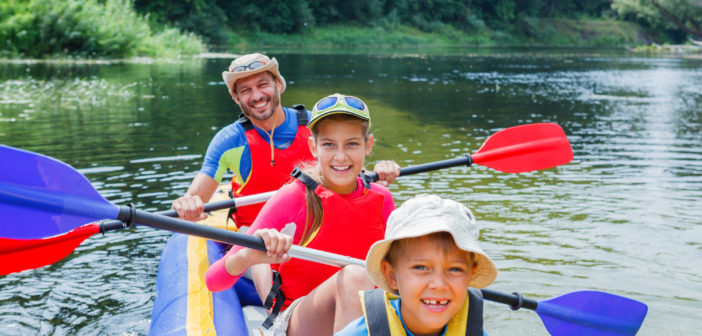Of all the casualties that occur in kayaks and canoes, 83% of them stem from not wearing a personal flotation device (PFD). The second largest factor in these deaths is alcohol consumption.
Avoiding life-threatening situations when kayaking is possible if you follow some basic safety rules.
Read on for our top 7 kayaking safety rules before you hit the water.
1. Kayak Safety Gear
Lifejackets are vital, even in shallow water. Getting flipped in shallow water could mean hitting your head on a rock or a boat. A PFD will keep you above water if you are unconscious.
Life jackets only work if they are the correct size. An adult life jacket on a child would be useless, so ensure your safety with the right size for everyone. A life jacket is also necessary to protect against hypothermia.
It is extremely difficult to swim in rapids or through felled trees. A personal floatation device will keep you above water until you can safely make it to shore.
Some people complain that a life jacket is uncomfortable. However, kayak safety gear is essential. If the fit is a problem, look into getting a PFD specifically designed for kayaks on the water. These are designed to be comfortable while on the water.
Invest in a small first-aid kit that can fit in your kayak.
2. Do Not Consume Alcohol
There is never a safe time to drink alcohol when operating any type of equipment. A kayak is no exception.
Weather conditions could change. You could head into fast currents or run into larger boats. You need to have your full mental capacity to handle these unexpected situations.
3. Check Before You Go
Before pushing off, you should always thoroughly check your equipment. Look for tears, rips or cracks in each piece of kayak equipment.
It is extremely important that you stay hydrated. Remember, kayaking is a physical activity and you will get thirsty. Pack enough water for your route so that you are not at risk for dehydration.
Bring enough food for your trip as well.
4. Dress for the Conditions
One of the most important kayaking safety rules is to always dress for the conditions.
If you plan to paddle in twilight make sure to dress in bright colors with reflective strips. Make sure others can see you!
Any time the temperature of the water is lower than 98.6 degrees, you begin to lose body heat to the water. This cold water can quickly lead to hypothermia if you go under.
Dress appropriately for the water temperature, the air temperature, and the forecast.
If you are taking your kayaks on the water when the water is cold, you may want to wear a wetsuit, drysuit, or paddling jacket. Check out the best wetsuits for kayaking.
A windbreaker may suffice in warm climates.
Bring a helmet if you are whitewater kayaking. For sea kayaking, pack a hat and sunglasses to protect your face and eyes from the sun.
Remember to apply wear sunblock on all exposed skin. Always put chapstick on your lips. Consider some gloves for your hands if it is especially windy or cold.
Think about your shoe choice. You should choose closed-toe shoes to protect your feet. Sneakers, water shoes or closed-toe sandals are all fine.
Before you head out, think about your gear from your head to your toes to make sure you have all your kayak safety gear ready.
5. Plan Your Course
Choose the right paddling location for your level of expertise. The best locations are protected from the wind and waves and have lots of spots you can go ashore.
Ideally, avoid spots with lots of boat traffic.
Calm bays, lakes, and rivers without strong currents are the best spots for novices.
Always tell someone what your paddle plan is. Let them know where you are going and how long you plan to be there.
Keep to your plan when you hit the water. This guarantees that if something goes wrong, your friend gives the authorities accurate information.
6. Learn to Re-Enter Your Kayak
The time to learn how to re-enter your kayak from the water is not when you need to do it for real.
If you can’t easily re-enter your kayak from the water, you should not be paddling anywhere further than swimming distance to shore.
If you are a newbie and thinking about purchasing your own kayak, keep in mind that a sit on top kayak is much easier to re-enter than one with a slit on the side.
However, it is possible to re-enter you kayak no matter what type you have. Practice makes perfect, so practice your technique over and over until you get the hang of it.
7. Take a Course
If you begin kayaking in water that is further from shore than you can swim, you need to protect yourself and your fellow kayakers.
When you reach this stage, it’s essential that you take an on-water course. These courses teach you exposed water rescue skills that can make all the difference in the outcome during a crisis.
There are also skill development classes you can take to help you become more proficient when you take your kayaks on the water.
These courses are well-worth the cost. They are investments that will add a layer of protection to your kayaking excursions.
Kayaking Safety Rules: Final Thoughts
There you go! 7 kayaking safety rules that will dramatically improve your safety on the water.
Be smart and stay safe. Kayaking can be a love of a lifetime with the proper respect for safety.
Next, read our complete guide to types of kayaks.




